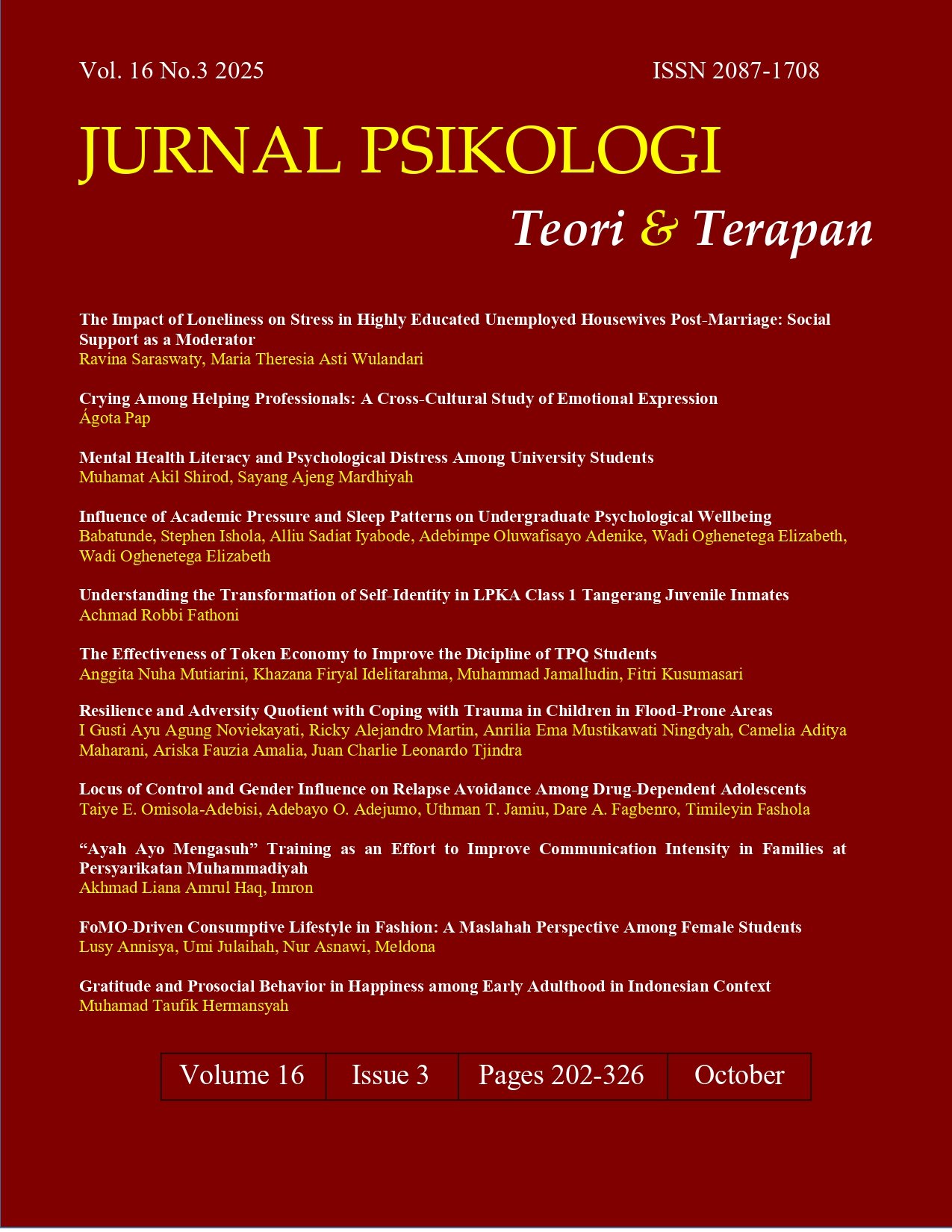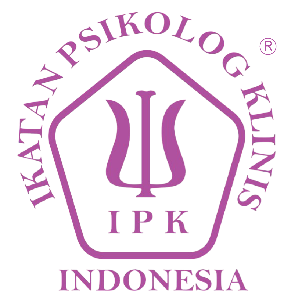Locus of Control and Gender Influence on Relapse Avoidance Among Drug-Dependent Adolescents
DOI:
https://doi.org/10.26740/jptt.v16n03.p281-289Keywords:
Drug-dependent adolescents, gender, locus of control, relapse avoidance abilityAbstract
Background: In Nigeria, few studies have investigated relapse avoidance ability and its antecedents among young adolescents. Objective: This study examined the role of locus of control and the influence of gender on relapse avoidance among adolescents undergoing treatment for substance use at the Federal Neuro-psychiatric Hospital, Yaba, Lagos State, Nigeria. Method: A cross-sectional survey design was employed to purposively select a sample of 344 adolescents (288 males and 56 females) using the adolescent relapse coping questionnaire and the Terry Pettijohn Locus of Control Scale for data collection. Results: Results indicated that Internal locus of control showed a positive effect (β = .17, p < .01), while external locus of control had a stronger influence (β = .25, p < .01) on relapse avoidance, together, they accounted for R²=.11%. No gender differences exist with relapse avoidance t(344) = -1.09 95% CI (-23.06, 6.61), p>.05). Conclusion: The study concluded that adolescents’ sense of control, rather than gender, plays a central role in relapse avoidance.
Abstrak
Latar Belakang: Di Nigeria, hanya sedikit penelitian yang telah meneliti kemampuan relapse avoidance ability dan faktor-faktor yang memengaruhinya di kalangan remaja muda. Tujuan: Penelitian ini menelaah peran locus of control dan pengaruh gender terhadap kemampuan menghindari kekambuhan pada remaja yang menjalani perawatan penyalahgunaan zat di salah satu rumah sakit, Yaba, Negara Bagian Lagos, Nigeria.
Metode: Penelitian ini menggunakan desain cross-sectional survey design dengan teknik purposive sampling untuk memilih sampel sebanyak 344 remaja. Data dikumpulkan menggunakan Adolescent Relapse Coping Questionnaire dan Terry Pettijohn Locus of Control Scale. Hasil: Hasil penelitian menunjukkan bahwa internal locus of control memiliki pengaruh positif (β = .17, p < .01), sedangkan external locus of control memiliki pengaruh yang lebih kuat (β = .25, p < .01) terhadap kemampuan menghindari kekambuhan. Secara bersama-sama, kedua variabel tersebut menjelaskan R² = .11%. Tidak ditemukan perbedaan berdasarkan gender terhadap kemampuan menghindari kekambuhan t(344) = -1.09, 95% CI (-23.06, 6.61), p > .05. Kesimpulan: Sense of control pada remaja lebih berperan dibandingkan faktor gender dalam kemampuan menghindari kekambuhan.
References
Ajayi, O. C., Esangbedo, A. E., Lawal, A. A., Ojo, T. I., Gbadegesin, A. O., & Olusegun, J. O. (2025). Relapse rates and admission correlates among patients admitted for a substance use disorder to the Federal Neuropsychiatric Hospital Yaba: A retrospective cross-sectional study. Nigerian Journal of Medicine, 34(1), 30–37. https://doi.org/10.4103/njm.njm_92_24
Bavojdan, M. R., Towhidi, A., & Rahmati, A. (2011). The relationship between mental health and general self-efficacy beliefs, coping strategies and locus of control in male drug abusers. Addiction & Health, 3(3–4), 111–118. https://pubmed.ncbi.nlm.nih.gov/24494125/
Becker, J. B., McClellan, M., & Reed, B. G. (2016). Sociocultural context for sex differences in addiction. Addiction Biology, 21(5), 1052–1059. https://doi.org/10.1111/adb.12383
Caputo, A. (2019). Addiction, locus of control and health status: A study on patients with substance use disorder in recovery settings. Journal of Substance Use, 24(6), 609–613. https://doi.org/10.1080/14659891.2019.1632948
Fagbenro, D. A., Idemudia, E. S., & Boehnke, K. (2025). Relationship between perceived material living conditions and subjective health and wellbeing as moderated by personal attributes in a representative sample of Nigerians. Frontiers in Psychology, 16, 1530302. https://doi.org/10.3389/fpsyg.2025.1530302
Fashola, T. M., Adebisi, T. E., Ibrahim, L., & Obisesan, O. A. (2025). Socio-environmental predictors of substance abuse among out-of-school adolescents. Open Access Library Journal, 12, e13447. https://doi.org/10.4236/oalib.1113447
Fernandes, L., & Mokwena, K. (2016). The role of locus of control in nyaope addiction treatment. South African Family Practice, 58(4), 153–157. https://doi.org/10.1080/20786190.2016.1223794
Fisher, R. A. (1925). Statistical methods for research workers (14th ed.). Hafner.
Furzer, B., Rebar, A., Dimmock, J. A., More, A., Thornton, A. L., & Wright, K. (2021). Exercise is medicine… when you enjoy it: Exercise enjoyment, relapse prevention efficacy, and health outcomes for youth within a drug and alcohol treatment service. Psychology of Sport and Exercise, 52, 101800. https://doi.org/10.1016/j.psychsport.2020.101800
Gachara, G., Wasanga, C., & Olaly, W. (2019). Relationship between locus of control and adherence to Alcoholics Anonymous meetings among persons recovering from substance abuse in Nairobi County, Kenya. International Journal of Education and Research, 7(6), 23–36.
Gaolaolwe, W., Moagi, M. M., Kovane, G. P., & Sehularo, L. A. (2025). A substance use relapse prevention programme for youth with substance use problems in Botswana. Health SA Gesondheid, 30, a2965. https://doi.org/10.4102/hsag.v30i0.2965
Hair, J. F., Black, W. C., Babin, B. J., & Anderson, R. E. (2010). Multivariate data analysis (7th ed.). Pearson.
Israel, U. N., Aroyewun, B. A., & Obi, L. (2024). Locus of control and impulsivity as correlates of substance use disorder among outpatients in a psychiatric hospital. IFE PsychologIA: An International Journal, 32(1), 30–39.
Kalungi, H., Kamacooko, O., Lunkuse, J. F., Namutebi, J., Naluwooza, R., Price, M. A., & Mayanja, Y. (2024). Prevalence and factors associated with illicit drug and high-risk alcohol use among adolescents living in urban slums of Kampala, Uganda. BMC Public Health, 24(1), 1709. https://doi.org/10.1186/s12889-024-19250-x
Lawal, A., Abdullahi, B., Olorukooba, A., Hamza, K., Usman, U., Abdulkadir, A., ... & Abubakar, A. (2025). Prevalence and factors associated with substance abuse among adolescents in public and private secondary schools in Katsina State, Nigeria. BMC Public Health, 25(1), 531. https://doi.org/10.1186/s12889-025-21739-y
Linquist, D. (2013). Locus of control, self-efficacy, and spiritual coping style among members of Alcoholics Anonymous (Master’s thesis). University of San Francisco.
Lipari, R., & Van Horn, S. (2017). The CBHSQ report: Children living with parents who have a substance use disorder. SAMHSA. https://www.samhsa.gov/data/sites/default/files/report_3223/ShortReport-3223.pdf
Lopes-Rosa, R., Kessler, F. P., Pianca, T. G., Guimarães, L., Ferronato, P., & Pagnussat, E. (2017). Predictors of early relapse among adolescent crack users. Journal of Addictive Diseases, 36(2), 136–143. https://doi.org/10.1080/10550887.2017.1295670
Malik, N. I., Saleem, S., Ullah, I., Rehan, S. T., De Berardis, D., & Atta, M. (2023). Psychosocial factors affecting drug relapse among youth in Punjab, Pakistan. Journal of Clinical Medicine, 12(7), 2686. https://doi.org/10.3390/jcm12072686
Malinao, D. (2024). A concurrent analysis of drug relapse risk, drug avoidance self-efficacy, and aftercare experiences among aftercare program clients. Technium Social Science Journal, 57, 134–182.
Minero, V., Best, D., Brown, L., Patton, D., & Vanderplasschen, W. (2022). Differences in addiction and recovery gains according to gender: Gender barriers and specific differences in overall strengths growth. Substance Abuse Treatment, Prevention, and Policy, 17(1), 21. https://doi.org/10.1186/s13011-022-00444-8
Muzingili, T., & Taruvinga, R. (2025). Gender as a predictor of relapse risk after adolescent drug and substance rehabilitation in Zimbabwe: A survival analysis approach. Journal of Substance Use, 30(1), 45–56. https://doi.org/10.1080/14659891.2025.2516517
Myers, M. G., & Brown, S. A. (1996). The Adolescent Relapse Coping Questionnaire: Psychometric validation. Journal of Studies on Alcohol, 57(1), 40–46. https://doi.org/10.15288/jsa.1996.57.40
Nath, A., Choudhari, S. G., & Dakhode, S. U. (2022). Substance abuse amongst adolescents: An issue of public health significance. Cureus, 14(11), e31193. https://doi.org/10.7759/cureus.31193
Nielsen, A. L., Scarpitti, F. R., & Inciardi, J. A. (1996). Integrating the therapeutic community and work release for drug-involved offenders: The CREST program. Journal of Substance Abuse Treatment, 13(4), 349–358. https://doi.org/10.1016/S0740-5472(96)00112-2
Okonkwo, C. C., Onyedibe, M. C., Okeke, A. N., & Agoha, B. C. (2020). Prevalence and socio-demographic factors of relapse among patients with substance use disorder in Lagos, Southwest Nigeria. Nigerian Journal of Psychology Research, 16(1), 1–8.
Patel, N., Sharma, H., Mahida, A., & Mistry, H. (2022). Relationship of alcohol use pattern with locus of control and impulsivity: A cross-sectional study in hospitalized alcohol use disorder patients in Western India. Journal of Family Medicine and Primary Care, 11(3), 987–993. https://doi.org/10.4103/jfmpc.jfmpc_1181_21
Pettijohn, T. F. (1992). Psychology: A concise introduction. Dushkin/McGraw-Hill.
Podsakoff, P. M., & Organ, D. W. (1986). Self-reports in organizational research: Problems and prospects. Journal of Management, 12(4), 531–544. https://doi.org/10.1177/014920638601200408
Rotter, J. B. (1966). Generalized expectancies for internal versus external control of reinforcement. Psychological Monographs: General and Applied, 80(1), 1–28. https://doi.org/10.1037/h0092976
Sanni, M., Bolu-Steve, N., Durosaro, A., & Adigun, A. (2021). Prevalence of drug relapse among clients in rehabilitation centres in North Central Nigeria: Implications for school counsellors. Canadian Journal of Family and Youth, 13(2), 14–25.
Silverman, M. J. (2010). The effect of a lyric analysis intervention on withdrawal symptoms and locus of control in patients on a detoxification unit: A randomized effectiveness study. The Arts in Psychotherapy, 37(3), 197–201. https://doi.org/10.1016/j.aip.2010.04.001
Singh, A., & Singh, D. (2011). Personality characteristics, locus of control and hostility among alcoholics and non-alcoholics. International Journal of Psychological Studies, 3(1), 99–105. https://doi.org/10.5539/ijps.v3n1p99
Sliedrecht, W., de Waart, R., Witkiewitz, K., & Roozen, H. G. (2019). Alcohol use disorder relapse factors: A systematic review. Psychiatry Research, 278, 97–115. https://doi.org/10.1016/j.psychres.2019.05.038
United Nations Office on Drugs and Crime (UNODC). (2014). World drug report 2014. United Nations Publications.
Wade, G. (2023). Minimum sample size estimation: The inverse square root and gamma‐exponential methods. Information Systems Journal, 28(1), 227–261
Downloads
Published
How to Cite
Issue
Section
License
Copyright (c) 2025 Taiye Esther Omisola-Adebisi , Adebayo Adejumo, Uthman T Jamiu, Dare A. Fagbenro, Timi Fashola

This work is licensed under a Creative Commons Attribution 4.0 International License.
Authors who publish in this journal agree to the following terms:
Copyright in any article is held by the author.
The author grants the journal, publication rights with the work simultaneously licensed under a Creative Commons Attribution License that allows others to share the work with an acknowledgment of the work's authorship and initial publication in this journal.
Authors may enter into separate, additional contractual arrangements for the non-exclusive distribution of the journal's published version of the work (e.g., posting it to an institutional repository or publishing it in a book), with an acknowledgment of its initial publication in this journal.
Authors are permitted and encouraged to post their work online (e.g., in an institutional repository or on their website) prior to and during the submission process, as this can lead to productive exchanges, as well as earlier and greater citation of published work.
 Abstract views: 101
,
Abstract views: 101
, PDF Downloads: 54
PDF Downloads: 54


















